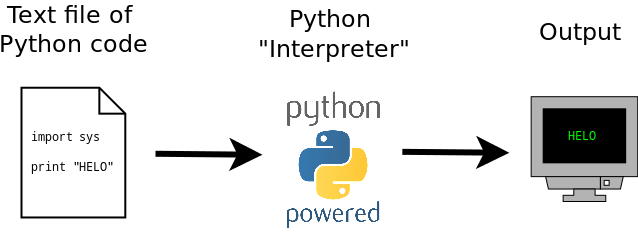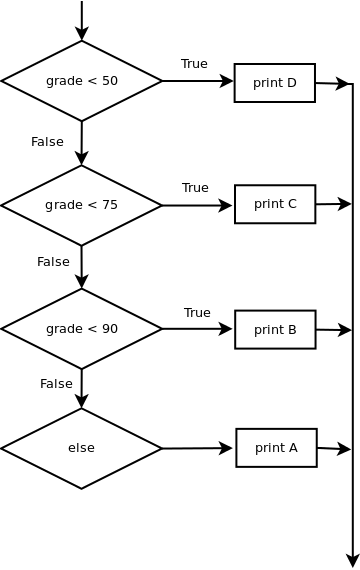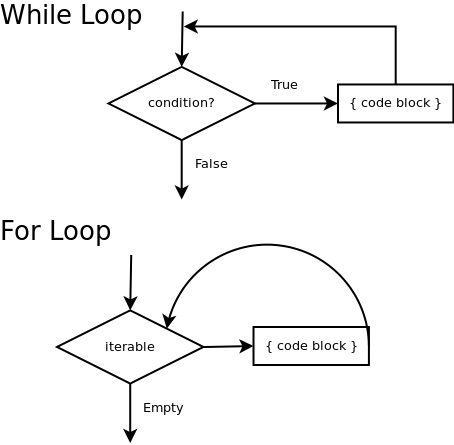What is Python?
- High-level, general purpose, dynamic programming language
- Created by Guido van Rossum in 1989
- Why is it called python?
"When he began implementing Python, Guido van Rossum was also
reading the published scripts from "Monty Python's Flying Circus",
a BBC comedy series from the 1970s. Van Rossum thought he needed a
name that was short, unique, and slightly mysterious, so he decided
to call the language Python."
– General Python FAQ
Programming in Python

Running Python programs
Run python program from the Linux command line:
Python versions
- Python 2 vs Python 3
- Python 2.x is legacy use 3
- Default python version on vortex is 2.7.5
- To use python 3 just run
python3:
$ python -V
Python 2.7.5
$ python3 -V
Python 3.6.8
$ module load bioconda/py37-biopython
$ python -V
Python 3.7.6
Code to all exercises
- In course project directory on vortex
/projects/academic/courses/bch519/spring21/exercises
Exercise 1: First Python Program
Type the following code into a text file named ex1.py
print("Hello World")
print("Just what do you think you're doing, Dave?")
print('Seq1: "hg19" ATCGCTGCAT')
Then run in the terminal by typing:
$ python3 ex1.py
Hello World
Just what do you think you're doing, Dave?
Seq1: "hg19" ATCGCTGCAT
What do errors look like?
Edit ex1.py and remove the first ‘p’ in print on the first line
Then re-run in the terminal by typing:
$ python3 ex1.py
File "ex1.py", line 1
rint "Hello World"
^
SyntaxError: invalid syntax
Exercise 1: What we learned
- Python programs are text files
- File names (typically) end in
.py
print displays the given text (without quotations)- The text inside quotes is called a string
- Python reports errors if the syntax is not correct
Exercise 2: Comments
Type the following code into a text file named ex2.py
# This is a comment, here to explain what the code is doing
# Anything after the # is ignored by python
print("Hello # World") # comments can be here
#
# HAL: It can only be attributable to human error.
#
print("Just what do you think you're doing, Dave?")
Then run in the terminal by typing:
$ python3 ex2.py
Hello # World
Just what do you think you're doing, Dave?
Exercise 2: What we learned
# Comments are important. They help yourself and others understand your code# Anything after the # is ignored by python# Good practice to always comment your code!
Exercise 3: Numbers
Type the following code into a text file named ex3.py
print(0 + 1 + 1 + 2 + 3 + 5 + 8)
print(22 % 5)
print(3 * 4 + 6 / 3)
Then run in the terminal by typing:
$ python3 ex3.py
20
2
14
Exercise 3: What we learned
- Python can do basic math
- Order of operations:
(3 * 4) + (6 / 3)
% = modulo operator
Exercise 4: Variables
Type the following code into a text file named ex4.py
seq_count = 10
gene = "NM_130786"
total = seq_count * 50
avg = total / seq_count
print(f"Gene {gene} has {seq_count} sequences")
print(f"The average number of sequences is: {avg}")
print(f"There's a total of {total} sequences")
Then run in the terminal by typing:
$ python3 ex4.py
On gene NM_130786 there are 10 sequences
The average number of sequences is: 50.0
There's a total of 500 sequences
Exercise 4: What we learned
Exercise 5: Strings
Type the following code into a text file named ex5.py
first = 'Marty'
last = "McFly"
gigawatts = 1.21
full_name = first + ' ' + last
greeting = f"Hello {first} {last}"
print(full_name)
print(greeting)
print(f'Achtung {first}, {gigawatts} gigawatts!')
print(f'{gigawatts:.3f} gigawatts')
# Another way to format strings
print("First: {0} Last: {1}".format(first, last))
Exercise 5: Output
Then run in the terminal by typing:
$ python ex5.py
Marty McFly
Hello Marty McFly
Achtung Marty, 1.21 gigawatts!
1.210 gigawatts
First: Marty Last: McFly
Exercise 5: What we learned
- Double quotes or single quotes may be used around literal strings
- the + operator concatenates strings together
f-strings can be used to concatenate strings{myvar:.3f} an optional ‘:’ and format specifier can follow the variable. This formats to 3 decimal places
Exercise 6: Printing Strings
Type the following code into a text file named ex6.py
chrom = 'chrom1'
start = 1002
end = 1012
print("chrom\tstart\tend")
print(f"{chrom}\t{start}\t{end}")
print("{0}:{1}-{2}, start = {1}".format(chrom, start, end))
print('What\'s the Gene\'s \\ fasta')
fasta = """>NM_130786
GGGCCTCATT
GCTGCAGACG
"""
print(fasta)
substr = chrom[1:4] # extract substring
print(substr)
Exercise 6: Output
Then run in the terminal by typing:
$ python3 ex6.py
chrom start end
chr1 1002 1012
chr1:1002-1012, start = 1002
What's the Gene's \ fasta
>NM_130786
GGGCCTCATT
GCTGCAGACG
hro
Exercise 6: What we learned
- Use a backslash
\ to escape special characters
\t prints a TAB character \n prints a newline''' triple-quote defines strings with many lines of text'{0} {1} {2} {1}' can re-use placeholders in format stringchrom[1:4] extracts a substring, starting from index 1 up to index 4 (not including)
index: 0 1 2 3 4 5
string: c h r o m 1
* * *
sub-string: hro
Conditionals
- A control structure controls the flow of a program
if = choice of whether to execute a block of codeif-elif-else = multiple block choicesfor loops = repeat a block multiple timeswhile loops = repeat a block multiple times
- Uses boolean expressions as conditions
Basic structure of the if statement
if boolean_condition:
code_block
elif: other_condition:
code_block
else:
code_block
Exercise 7: Conditionals
Type the following code into a text file named ex5.py
if 5 > 4:
print("Five is greater than four")
if "Hello" == "HELLO":
print("This will not print")
grade = 83.5;
if grade < 50:
print("D")
elif grade < 75:
print("C")
elif grade < 90:
print("B")
else:
print("A")
Exercise 7: Output
Then run in the terminal by typing:
$ python3 ex7.py
Five is greater than four
B
Example flow control

Boolean Logic
| p |
q |
p and q |
p or q |
| T |
T |
T |
T |
| T |
F |
F |
T |
| F |
T |
F |
T |
| F |
F |
F |
F |
Exercise 8: Boolean Operators
Join two or more boolean expressions with and/or logic
a = 10
b = 5
c = 7
print(a > b and a > c) # TRUE
print(c > a and c > b) # FALSE
print(a > b and b > c) # FALSE
print(c > a or c > b) # TRUE
print(a < c or b > c) # FALSE
Exercise 7 & 8: What we learned
- Conditional constructs allow execution of code given some condition is true/false
- Join two or more boolean expressions with and/or logic operators
- Spacing is important!
- Code under the
if needs to be indented 4 spaces
Python builtin operators
| Arithmetic/Boolean | Comparison operators |
|---|
| + | addition | == | equality |
| - | subtraction | != | inequality |
| * | multiplication | < | strictly less than |
| / | division | > | strictly greater than |
| ** | exponentiation | <= | less than or equal |
| % | modulo | >= | greater than or equal |
| and | and | is | object identity |
| or | or | is not | negated object identity |
| not | not | |
Loops
Allows execution of the same code a number of times
Basic structure of looping constructs
while boolean_condition:
code_block
for i in range(0,10):
code_block
for i in ['X','Y','Z']:
code_block
Example flow control

Exercise 9: Loops
Type the following code into a text file named ex9.py
x = 0
while x != 5:
print(x)
x = x + 1
message = "Hello"
for char in message:
print(char)
chroms = ['chr1', 'chr2', 'chr3']
for c in chroms:
if c == 'chr2':
continue
print(c)
Exercise 9: Output
Then run in the terminal by typing:
$ python3 ex9.py
0
1
2
3
4
H
e
l
l
o
chr1
chr3
Exercise 10: Nesting loops
- Loops can also be nested
- For example, looping through rows/cols of a matrix
for i in range(0, 5):
for j in range(0, 5):
print("row: {} col: {}".format(i,j))
Exercise 9 & 10: What we learned
- loop constructs allow execution of code multiple times
- code under the
for needs to be indented 4 spaces
for loops over a list of values (iterable)continue command starts next iteration of the loop - Loops can be nestedstrings are iterable
Executing Python programs
To run a Python program from the Linux command line:
$ python3 myprogram.py
Alternatively, ensure the first line of your script contains:
#!/usr/bin/env python3
Make your script executable and run:
$ chmod +x myprogram.py
$ ./myprogram.py
Homework #2
Due: 2021-02-23 09:00:00



